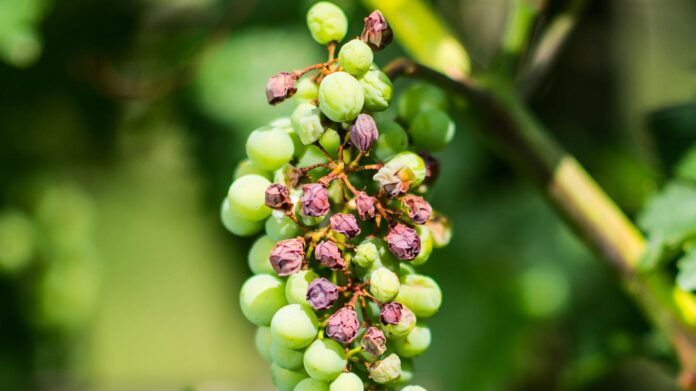
Scorching heat, hardly a drop of rain for a long time and then rain again without a break: climate change is a real challenge for the wine industry. Slopes in traditional growing areas could soon be left fallow in droves. But the changing climate not only makes the cultivation of vines more difficult, it also affects how the wine tastes.
“Wine quality is very sensitive to the temperature during grape ripening,” writes a research team from the French engineering school Bordeaux Sciences Agro led by Cornelis van Leeuwen in an overview study published in the journal “Nature Reviews Earth & Environment.” There are a whole range of factors that are responsible for this.
Ramón Mira de Orduña Heidinger from ETH Zurich also describes this in an overview study in the journal “Food Research International”. The higher temperatures, for example, lead to a lower malic acid content in the grapes. The heat also reduces the potassium levels, thus causing a lower pH value.
Overripe fruit note instead of fresh fruit taste
According to the French research team, rising temperatures mean that wine has less of the aroma of fresh fruit and more of a note of cooked or overripe fruit. The lower pH value in particular takes away some of the feeling of freshness. Less acidity can lead to less microbiological stability and thus to off-flavors.
The sugar content, however, increases in hot weather and so does the amount of alcohol. Higher alcohol levels are already being found in wine in Alsace and Bordeaux. Mira de Orduña Heidinger, a microbiologist specializing in oenology, points out that there are now significantly more wines on the market with 13, 14 or even 15 percent alcohol content. Wine critics complain about “heady” and “hot” wines.
Forest fires can also affect the taste
According to the wine expert, high temperatures could also lead to a paler complexion in young red wines and fewer odorous substances in Sauvignon Blanc, for example. Forest and bush fires, which are increasing with climate change, could also have an influence. In Australia, burnt and ash-like smoke aftertastes in wine have already been criticized.
The industry has long recognized the problem. “Viticultural practices can make it possible to correct these effects without calling into question the definition of wine by working on the selection of suitable microorganisms, the desugaring of the must, the reduction of the alcohol content and the acidification of the wines,” writes the French Wine Institute in a strategy paper on climate change.
Conservative consumers require cultivation tricks
In Germany, too, improvements are being made: “The winemakers I know actually all have a tendency to maintain the current stylistic typicality of their wines because they have a market for it,” says Heiko Paeth, a climate impact expert from the University of Würzburg who researches viticulture. “The German consumer is conservative.”
Low-acid, high-proof wines taste brandy, says Paeth. Almost nobody likes them. “People want to drink young, white, fruity, but still dry white wines, especially the younger generation.”
There are “ecological tricks” to maintain the taste. “For example, if I want a wine that doesn’t have too high a sugar content, so that it doesn’t have too high an alcohol content, but still has the acidity, I just have to make sure that I get less radiation on the grapes by cutting the leaves.”
Franconia may be the new Bergerac or Bordeaux
Of course, it is also possible to switch to other grape varieties because of climate change, says Paeth. Today, much more red wine is grown in Germany than decades ago, but in Franconia the area is already shrinking again. “The winegrowers quickly realized that they would not be able to get the shift in the range of grape varieties through to the market very well.” The winegrowers have a lot of potential for adaptation and are trying out a lot, says Paeth.
Paeth is looking for analog climates for the Bavarian State Institute for Viticulture and Horticulture. He is therefore investigating what the climate will be like in 50 or 70 years in the vineyards from which, according to the institute, the best Silvaner comes today. He then looks to see where the temperature, radiation, humidity, late frosts and other characteristics correspond to this. The project is not yet complete, but they are looking towards southwest France. “That means that in two generations the Franconian vineyards will have roughly the same existing climate as in Bergerac or Bordeaux.”
As soon as a location is found, the state institute wants to plant a very heat-resistant Silvaner clone there. This will help them find out how to cultivate it in the warmer climate – and what needs to be done in the cellar so that the wine tastes as if it had been grown in Würzburg.
Massive areas of cultivation could be lost
The research team from Bordeaux has found that by the end of the century, 20 to 70 percent of the cultivated area in Europe in traditional wine regions could disappear – depending on how much the earth heats up.
The vines in Central Europe are mainly on the south-facing slopes, adds Paeth. It is gradually becoming too hot for them, so winemakers are increasingly planting beyond the classic south-facing slopes. “This is something that is slow, but in my opinion it will be the way in which we can maintain our range of grape varieties and thus the typicality of our wines and work in the same wine-growing regions over the next few decades.”
© dpa-infocom, dpa:240910-930-228035/1
This is a message directly from the dpa news channel.
